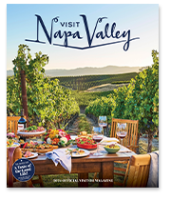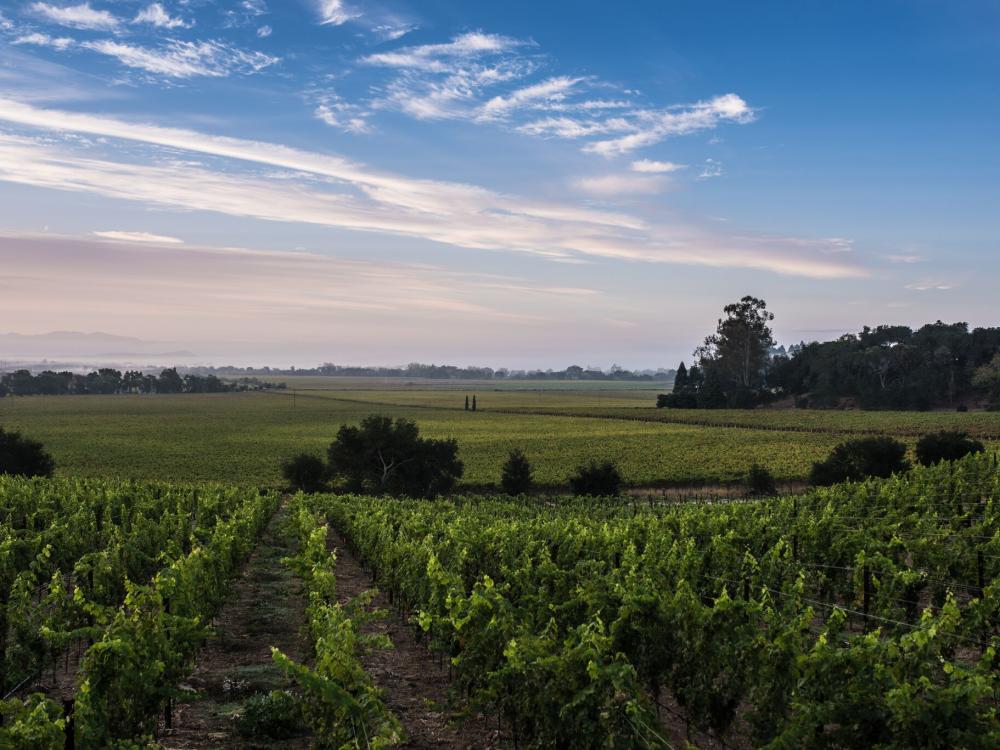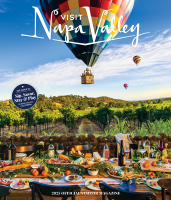Napa Valley 101
Location:
The Napa Valley is approximately 70 miles (112 km) from San Francisco International Airport (SFO); 63 miles (101 km) from Oakland International Airport (OAK); and 75 miles (120 km) from Sacramento International Airport. There are many transportation options to the Napa Valley; including airport shuttles or limousine services; renting a car; or taking public transportation.
Size:
While one of the most well known wine regions in the world, Napa Valley is also one of the smallest. The valley floor is just 30 miles long and five miles across at its widest point.
Time Zone:
The Napa Valley is in the Pacific Time Zone (PTZ), observing daylight savings from mid-March to late October.
Weather & Climate:
The Mediterranean climate of the Napa Valley provides near perfect weather year round. The southern part of the valley is much cooler than the northern part and temperatures vary from day to night. Spring and summer temperatures range from 75 – 85 degrees Fahrenheit (24-29 degrees Celsius) during the day and 50 – 55 degrees F (10 – 13 C) at night. In fall and winter, temperatures range from 60 – 70 degrees F (15 – 21 C) during the day and 40 – 50 degrees F (5 – 10 C) at night.
The Towns of Napa Valley
The Napa Valley consists of the following distinctive towns, including, from north to south, Calistoga, St. Helena, Rutherford/Oakville, Yountville, the city of Napa, American Canyon, and the outdoor recreation area of Lake Berryessa.
Population:
American Canyon: Population: 20,000; Size: 4.8 square miles
Napa: Population: 79,000 (2013); Size: 18.1 square miles
Lake Berryessa: Population: 1,639 (2013); Size: 15 miles long; 3 miles wide
Yountville: Population: 2,973 (2013); Size: 1.5 square miles
Oakville: Population: 71 (2010); Size: 1.3 square miles
Rutherford: Population: 164 (2010); Size: 1.7 square miles
St. Helena: Population: 5,947 (2013); Size: 4 square miles
Calistoga: Population: 5,155(2010); Size: 2.5 square miles
Lodging:
There are nearly 150 overnight accommodation options to choose from in the Napa Valley, including hotels, resorts, country inns, and bed and breakfasts. Whether your preference is modern, historical, “in-town” close to restaurants and shops, a luxurious spa getaway, or the calm of a remote vineyard setting, the Napa Valley caters to every visitor’s needs. Click here for a complete list of overnight accommodations.
Tax Rates:
Sales tax in Napa Valley is 8%; the transient occupancy tax (TOT or hotel tax) is 14% percent (fees in Napa County include a 12 percent occupancy tax and a 2% percent Tourism Improvement District assessment (NVTID).
Tourism:
Tourism is one of the largest industries in the Napa Valley, and supports an estimated 11,776 jobs, with the majority of these jobs in either the hotel or restaurant industries.
In 2014, the Napa Valley welcomed a total of 3.3 million visitors (86.4 percent of visitors were from the United States and 13.6 percent were international visitors).
Napa Valley Attractions and Experiences:
While the Napa Valley offers many unique experiences for visitors, visiting wineries and/or tasting rooms remains the most popular visitor experience. Below is a breakdown of how Napa Valley experiences were ranked in a 2014 visitor profile study.
Visiting wineries and/or tasting rooms: 82.3 percent
Dining in restaurants: 69.4 percent
Winery tours: 52.6 percent
Shopping: 40.3 percent
Spa treatments: 12.1 percent
Napa Valley Wine Train: 10.3 percent
Nightlife: 10.1 percent
Art: 8.6 percent
Farmer’s markets: 8.5 percent
Guided tours: 8.3 percent
State or local parks: 8 percent
Culinary activities: 7.6 percent
Hiking: 6.2 percent
Festivals or special events: 4.7 percent
Biking: 3.4 percent
Hot air ballooning: 2.8 percent
Golf: 1.7 percent
Restaurants:
Napa Valley is home to more than 125 restaurants and has more Michelin stars per capita than any other wine region in the world. Click here for a comprehensive list of restaurants in the Napa Valley.
Gratuities:
Most restaurants do not include a service fee in checks. The average tip or gratuity for restaurant servers is 15-20% of the total check (before tax). Standard service fees are becoming more common and a tip is sometimes included for groups of six or more. While tipping is not necessary when wine tasting, for exceptional service, it is appreciated.
Health & Wellness:
Home to the country’s first agricultural preserve and a land trust that has permanently protected more than 10 percent of the county from residential and commercial development, the Napa Valley offers more than 53,000 acres of protected land and provides ideal hiking, biking and paddling opportunities for visitors of all physical abilities to enjoy. Click here for suggestions on sports and outdoor activities in the Napa Valley.
Arts & Culture:
The Napa Valley is home to art, film, music, and architecture on both intimate and grand scales. Revolving art exhibitions at wineries, permanent and special museum exhibitions, art galleries, open studios, historic and contemporary architecture, and art festivals all provide a cultural experience that is legendary. Explore local arts attractions and curate your own Napa Valley experience. Click here for ideas on what to see and do while in the Napa Valley.
Shopping:
The Napa Valley features an array of locally owned boutiques and specialty shops which offer everything from fine art, to handcrafted jewelry, to one-of-a-kind apparel. Click here for a list of shopping options in the Napa Valley.
Historical Facts:
The first wine grapes were planted in Napa Valley in 1838 by George Yount, for whom the town of Yountville is named.
The first commercial winery in the county was opened by John Patchett in 1859 in what is now the city of Napa.
The oldest commercial winery still in operation is Charles Krug, founded in 1861.
Before wine grapes became the Valley’s biggest crop, prunes held first place.
The white wine that won the 1976 Judgment of Paris wine tasting was a 1973 Chardonnay from Chateau Montelena and the red wine that won was a Stag’s Leap Wine Cellars 1973 Cabernet Sauvignon. This is the first time California wines beat out France, changing the world’s view of California wines. The year 2016 marks the 40th anniversary of this tasting.
Wine Facts:
95% of Napa Valley’s more than 475 wineries are family owned.
Napa Valley is an American Viticultural Area or AVA and within it exists 16 additional AVAs, including Calistoga, Oakville, Yountville, and Coombsville.
Only 9% (about 45,000 acres) of Napa County’s 504,450 acres are planted to grapes.
The largest private owner of vineyards in Napa Valley is Andrew Beckstoffer. The largest corporate owner is Diageo.
67% of Napa Valley wineries produce fewer than 5,000 cases annually.
Only 4% of California’s wine comes from Napa Valley, but the value of Napa Valley wine makes up 27% of the retail value of all California wine sold.
Fun Wine Facts:
It takes about six to eight clusters, or approximately 600-800 wine grapes (2.4 pounds) to produce a bottle of wine.
One barrel of wine contains 740 pounds of grapes, equivalent to 59 gallons or 24.6 cases of wine.
An annual average of 892 million gallons of wine is consumed in the United States each year.
The Napa Valley soil profile is more complex than any other wine region in the world and represents 100 soil variations and 33 soil series. Half of all the soil orders in the world are found in Napa Valley.
Wine Tasting Fees:
Most wine tasting rooms in Napa Valley charge a fee, however, sometimes this is waived with wine purchases.








